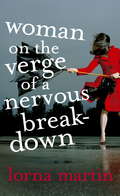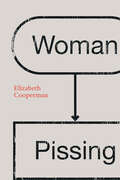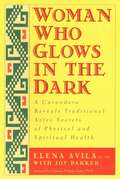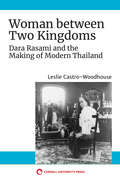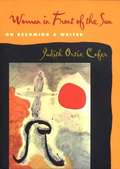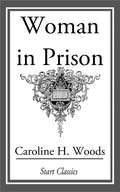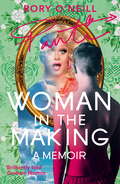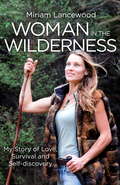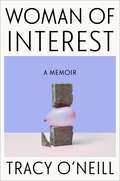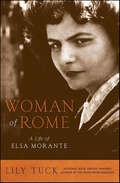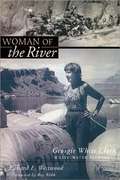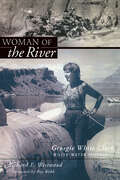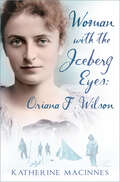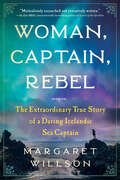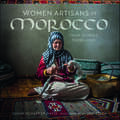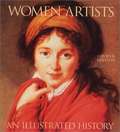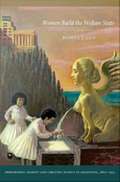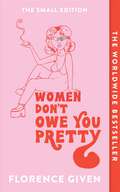- Table View
- List View
Woman On The Verge Of A Nervous Breakdown
by Lorna MartinLorna Martin's life is in chaos and she needs to make some big changes. After all, there must be a reason she keeps chasing after the wrong men, making toe-curling blunders at work and generally failing to keep her life on track. Egged on by her friends, she signs up for the talking cure: a year of therapy with the frosty Dr J. Along the way, she catches sight of the holy grail of true love in the shape of the gorgeous Dr McDreamy. But will Lorna find her own happy ending? With support (and not a little exasperation) from her friends and long-suffering sister, some serious setting-the-world-to-rights sessions involving too many bottles of wine, and the help of her inscrutable shrink, Lorna feels she might be getting her life together.Revealing, intimate and highly entertaining, Woman on the Verge of a Nervous Breakdown is a must-read for any woman who loves the idea of being in love and worries about settling for second best.
Woman Pissing
by Elizabeth CoopermanWhen we think of prototypical artists, we think of, say, Picasso, who made work quickly, easily, effervescently. On the contrary, in Woman Pissing, a literary collage that takes its title from a raunchy Picasso painting, Elizabeth Cooperman celebrates artists—particularly twentieth-century women artists—who have struggled with debilitating self-doubt and uncertainty. At the same time, Cooperman grapples with her own questions of creativity, womanhood, and motherhood, considering her decade-long struggle to finish writing her own book and realizing that she has failed to perform one of the most fundamental creative acts—bearing a child.Woman Pissing is composed of roughly one hundred short prose &“paintings&” that converge around questions of creativity and fecundity. As the book unfolds it builds a larger metaphor about creativity, and the concerns of artistry and motherhood begin to entwine. The author comes to terms with self-doubt, inefficiency, frustration, and a nonlinear, circuitous process and proposes that these methods might be antidotes to the aggressive bravura and Picassian overconfidence of ego-driven art.
Woman Who Glows in the Dark: A Curandera Reveals Traditional Aztec Secrets of Physical and Spiritual Health
by Elena Avila Joy ParkerAn autobiographical account of how a psychiatric nurse specialist became a folk medicine healer; this also explains the origins and practice of one of the oldest forms of medicine in the New World.
Woman between Two Kingdoms: Dara Rasami and the Making of Modern Thailand
by Leslie Castro-WoodhouseWoman Between Two Kingdoms explores the story of Dara Rasami, one of 153 wives of King Chulalongkorn of Siam in Thailand during the late nineteenth and early twentieth centuries. Born in a kingdom near Siam called Lan Na, Dara served as both hostage and diplomat for her family and nation. Thought of as a "harem" by the West, Siam's Inner Palace actually formed a nexus between the domestic and the political. Dara's role as an ethnic "other" among the royal concubines assisted the Siamese in both consolidating the kingdom's territory and building a local version of Europe's hierarchy of civilizations. Dara Rasami's story provides a fresh perspective on both the socio-political roles played by Siamese palace women, and how Siam responded to the intense imperialist pressures it faced in the late nineteenth century.
Woman in Front of the Sun: On Becoming a Writer
by Judith Ortiz CoferIn this collection of essays woven with poems and folklore, Judith Ortiz Cofer tells the story of how she became a poet and writer and explores her love of words, her discovery of the magic of language, and her struggle to carve out time to practice her art. A native of Puerto Rico, Cofer came to the mainland as a child. Torn between two cultures and two languages, she learned early the power of words and how to wield them. She discovered her love for the subtleties, sounds, and rhythms of the written word when a Roman Catholic nun and teacher bent on changing traditions for the better gave her books of high literature to read, some of which were forbidden by the church. Later, as an adult, demands from her family and her profession made it difficult for Cofer to find time to devote to her art, but her need and determination to express herself led to solutions that can help all artists challenged with the limits of time. Cofer recalls the family cuentos, or stories, that inspire her and shows how they speak to all artists, all women, all people. She encourages her readers to insist on the right to be themselves and to pursue their passions. A book that entertains, instructs, and enthralls, Woman in Front of the Sun will be invaluable to students of poetry and creative nonfiction and will be a staple in every creative writing classroom as well as an inspiration to all those who write.
Woman in Prison
by Caroline H. WoodsWhile I was waiting, that advertisement returned to my reflections, and urged its cause imperatively as a command. It was a call, to me, resistless as the voice that awoke the young Israelitish Prophet from his slumbers. In another moment the struggle with my pride was over, and my spirit answered,--I will go, even to lust-besotted Sodom if thou leadest, Light of my path! I seated myself in a street car, went to the prison, applied for the place, and obtained it. Day by day I wrote down what I saw and heard, what I said and did. Why? In obedience to the same Voice that called me to the work. The tale is before you. May it touch the heart of every one who reads the story, and melt it into a compassion which will labor for the redemption of the prisoner; into a pity which will echo around the cry--Open the prison doors, not to let the prisoner go free, but to let in, to him, the light of moral knowledge, and the discipline of Christian charity.
Woman in the Making: Panti's Memoir
by Rory O'Neill'Today, as I walked through Dublin city centre, I saw gay couples casually holding hands as they strolled, and kissing each other goodbye at bus stops in the late spring sunshine, and it seemed to me that all was changed, changed utterly ...'- From the Prologue, written three days after Ireland became the first country in the world to embrace marriage equality through popular voteWoman in the Making is the unforgettable story of how a little boy from a small Irish village in the west grew up to become Panti Bliss, Queen of Ireland and voice of a brave new nation embracing equality, all the colours of the rainbow and, most of all, a glamorous attitude.
Woman in the Making: Panti's Memoir
by Rory O'Neill1968. In a small town in the west of Ireland, a beautiful baby boy is born. He enjoys an idyllic country childhood: privileged, carefree, surrounded by love - and pet sheep. Eleven years later, the Pope visits Ireland, and things will never be the same again. At the Pontiff's mass in Knock, the little boy has an epiphany that will set him on the road to become the biggest, boldest, and most opinionated drag queen Ireland has ever known. This is the story of Rory O'Neill's journey from the fields to becoming Panti Bliss, the voice of a brave new nation embracing diversity, all the colours of the rainbow and, most of all, a glamorous attitude. It's also the story of a misfit who turned his difference into a triumphant art form; of coming to terms with HIV; of political activism; and of 'Pantigate', and the speech that touched a million lives. Welcome to the world of Panti - adored, fun drunk aunt to the world - and her creator Rory, in their own inimitable words.
Woman in the Mists: The Story of Dian Fossey and the Mountain Gorillas of Africa
by Farley MowatDeep in Central Africa live some of the most intriguing animals on earth: the mountain gorillas. The extraordinary woman who pursued her dream to study them was Dian Fossey.
Woman in the Nineteenth Century
by Margaret C. FullerThe book is both an inner exploration of Margaret Fuller's personal quest for self-fulfillment and the first American extended polemical statement defining and advocating women's rights.
Woman in the Wilderness: My Story of Love, Survival and Self-Discovery
by Miriam Lancewood'An intriguing and mesmerising book' Ben FogleMy life is free, random and spontaneous. This in itself creates enormous energy and clarity in body and mind - Miriam LancewoodMiriam Lancewood is a young Dutch woman living a primitive, nomadic life in the heart of the mountains with her New Zealand husband. She lives simply in a tent or hut and survives by hunting wild animals, foraging edible plants and using minimal supplies. For the last six years she has lived this way, through all seasons, often cold, hungry and isolated in the bush. She loves her life and feels free, connected to the land and happy.This book tells her story, including the very practical aspects of such a life: her difficulties learning to hunt with a bow and arrow, struggles to create a warm environment in which to live, attempts to cross raging rivers safely and find ways through the rugged mountains and dense bush. This is interwoven with her adjustment to a very slow pace of life, her relationship with her much older husband, her interactions with the few other people they encounter, and her growing awareness of a strong spiritual connection to the natural world.
Woman of Interest: A Memoir
by Tracy O'NeillMOST ANTICIPATED READ and MUST READ OF 2024: The Millions, LitHub, Esquire, BookRiot, Bustle, Vulture, Boston Globe, Brit & Co, Southern LivingA National Book Foundation’s 5 Under 35 honoree delivers her first work of nonfiction: a compulsively readable, genre-bending story of finding her missing birth mother and, along the way, learning the priceless power of self-knowledge.In 2020, Tracy O’Neill began to rethink her ideas of comfort and safety. Just out of a ten-year relationship and thirtysomething, she was driven by an acute awareness that the mysterious mother she’d never met might be dying somewhere in South Korea.After contacting a grizzled private investigator, O’Neill took his suggested homework to heart when he disappeared before the job was done, picking up the trail of clues and becoming her own hell-bent detective. Despite COVID-19, the promise of what she might discover—the possibility that her biological mother was her kind of outlaw, whose life could inspire her own—was too tempting.Written like a mystery novel, Woman of Interest is a tale of self-discovery and fugitivity from convention that features a femme fatale of unique proportions, a former CIA operative with a criminal record, and a dogged investigator of radical connections outside the nuclear family. O’Neill gorgeously bends the detective genre to her own will as a writer, stepping out of the shadows of her own self-conception to illuminate the hopes of the woman of interest she is both chasing and becoming.
Woman of Rome: A Life of Elsa Morante
by Lily TuckThe first biography in any language of one of the most celebrated Italian writers of the twentieth century.Born in 1912 to an unconventional family of modest means, Elsa Morante grew up with an independent spirit, a formidable will, and an unshakable commitment to writing. Forced to hide from the Fascists during World War II in a remote mountain hut with her husband, renowned author Alberto Moravia, she re-emerged at war's end to take her place among the premier Italian writers of her day. When Rome was film capital of the world, she counted Pasolini, Visconti, and the young Bertolucci among her circle of friends. She was charismatic, beautiful, and fiercely intelligent; her marriage, a passionate union of literary giants, captivated a nation; her love affairs were intense and often tragic. And until now few Americans have known of this remarkable woman and her powerful, original talent.
Woman of the River
by Richard E. WestwoodGeorgie White Clark-adventurer, raconteur, eccentric--first came toknow the canyons of the Colorado River by swimming portions of them witha single companion. She subsequently hiked and rafted portions of thecanyons, increasingly sharing her love of the Colorado River withfriends and acquaintances. At first establishing a part-time guideservice as a way to support her own river trips, she went on to becomeperhaps the canyons' best-known river guide, introducing their rapids tomany others-on the river, via her large-capacity rubber rafts, andacross the nation, via magazine articles and movies. Georgie Clark sawthe river and her sport change with the building of Glen Canyon Dam,enormous increases in the popularity of river running, and increasedNational Park Service regulation of rafting and river guides. Adjusting,though not always easily, to the changes, she helped transform an eliteadventure sport into a major tourist activity.
Woman of the River: Georgie White Clark White-Water Pioneer
by Richard WestwoodThe great adventurer who helped make whitewater rafting a beloved national pastime comes to vivid life in this rollicking biography. Georgie White Clark—adventurer, raconteur, eccentric—first came to know the canyons of the Colorado River by swimming portions of them with a single companion. She subsequently hiked and rafted portions of the canyons, increasingly sharing her love of the Colorado River with friends and acquaintances. At first establishing a part-time guide service as a way to support her own river trips, Clark went on to become perhaps the canyons&’ best-known river guide, introducing their rapids to many others, both on the river, via her large-capacity rubber rafts, and across the nation, via magazine articles and movies. Georgie Clark saw the river and her sport change with the building of Glen Canyon Dam, enormous increases in the popularity of river running, and increased National Park Service regulation of rafting and river guides. Adjusting, though not always easily, to the changes, she helped transform an elite adventure sport into a major tourist activity.
Woman with a Movie Camera: My Life as a Russian Filmmaker (Constructs Series)
by Marina GoldovskayaMarina Goldovskaya is one of Russia's best-known documentary filmmakers. The first woman in Russia (and possibly the world) to combine being a director, writer, cinematographer, and producer, Goldovskaya has made over thirty documentary films and more than one hundred programs for Russian, European, Japanese, and American television. Her work, which includes the award-winning films The House on Arbat Street, The Shattered Mirror, and Solovky Power, has garnered international acclaim and won virtually every prize given for documentary filmmaking. In Woman with a Movie Camera, Goldovskaya turns her lens on her own life and work, telling an adventurous, occasionally harrowing story of growing up in the Stalinist era and subsequently documenting Russian society from the 1960s, through the Thaw and Perestroika, to post-Soviet Russia. She recalls her childhood in a Moscow apartment building that housed famous filmmakers, being one of only three women students at the State Film School, and working as an assistant cameraperson on the first film of Andrei Tarkovsky, Russia's most celebrated director. Reviewing her professional filmmaking career, which began in the 1960s, Goldovskaya reveals her passion for creating films that presented a truthful picture of Soviet life, as well as the challenges of working within (and sometimes subverting) the bureaucracies that controlled Russian film and television production and distribution. Along the way, she describes a host of notable figures in Russian film, theater, art, and politics, as well as the technological evolution of filmmaking from film to video to digital media. A compelling portrait of a woman who broke gender and political barriers, as well as the eventful four decades of Russian history she has documented, Woman with a Movie Camera will be fascinating reading for a wide audience.
Woman with the Iceberg Eyes: Oriana F. Wilson
by Katherine MacInnesCaptain Scott’s adventure in the Antarctic, the most famous story of exploration in the world, played out on the great ice stage in the south. Oriana Wilson, wife of Scott’s best friend Dr Edward Wilson, was watching from the wings. She is the missing link between many of the most famous names, the lens through which their secrets are revealed. What really happened both in Antarctica and at home? This book presents a valuable and exciting perspective on the golden myth – the widow’s story. Ory’s status as an Antarctic widow gave her access to an unprecedented range of evidence on Scott’s team but it also allowed her into a man’s world at a time when the British Suffragettes were marching. True to her gender and her time, Ory began as the dutiful housewife, but emerged as a scientist and collector in her own right, and the first white woman to venture into the jungles of Darwin, Australia. Ory has been quiet for a century – this biography gives her a voice and gives us a unique view of the first half of the twentieth century seen through her clear blue ‘iceberg eyes’.
Woman, Captain, Rebel: The Extraordinary True Story of a Daring Icelandic Sea Captain
by Margaret WillsonA daring and magnificent historical narrative nonfiction account of Iceland's most famous female sea captain who constantly fought for women's rights and equality—and who also solved one of the country's most notorious robberies.Every day was a fight for survival, equality, and justice for Iceland's most renowned female fishing captain of the 19th century.History would have us believe the sea has always been a male realm, the idea of female captains almost unthinkable. But there is one exception, so notable she defies any expectation.This is her remarkable story.Captain Thurídur, born in Iceland in 1777, lived a life that was both controversial and unconventional. Her first time fishing, on the open unprotected rowboats of her time, was at age 11. Soon after, she audaciously began wearing trousers. She later became an acclaimed fishing captain brilliant at weather-reading and seacraft and consistently brought in the largest catches. In the Arctic seas where drownings occurred with terrifying regularity, she never lost a single crewmember. Renowned for her acute powers of observation, she also solved a notorious crime. In this extremely unequal society, she used the courts to fight for justice for the abused, and in her sixties, embarked on perilous journeys over trackless mountains.Weaving together fastidious research and captivating prose, Margaret Willson reveals Captain Thurídur's fascinating story, her extraordinary courage, intelligence, and personal integrity.Through adventure, oppression, joy, betrayal, and grief, Captain Thurídur speaks a universal voice. Here is a woman so ahead of her times she remains modern and inspirational today. Her story can now finally be told.Praise for Woman, Captain, Rebel:"Meticulously researched and evocatively written, Woman, Captain, Rebel provides not only a captivating insight into 19th-century Iceland, but also introduces readers to the inspirational, real-life fishing captain Thurídur, a tough and fiercely independent woman who deserves to be a role model of determination and perseverance for us all." —Eliza Reid, internationally bestselling author of Secrets of the Sprakkar"A crime has been committed in 19th century Iceland and in steps a mysterious seawoman moonlighting as a detective, dressed in male clothes. Margaret Willson unravels this legendary casework of Captain Thurídur, down to the finest detail, with a brilliant portrait of old Iceland by the sea." —Egill Bjarnason, author of How Iceland Changed the World"Reading about this remarkable woman's journey will challenge your ideas about history and change yours too." —Major General Mari K. Eder, author of The Girls Who Stepped Out of Line"All credit to Margaret Willson for excavating the story of Thurídur Einarsdóttir in a century which can at long last appreciate this feisty and resilient Icelandic seafarer. The meticulous research is worn so lightly that it reads like a saga." —Sally Magnusson, author and broadcaster"A beautiful story of one woman's perseverance against tragedy, hardship, and the open seas." —Katharine Gregorio, author of The Double Life of Katharine Clark"With a clear, compelling narrative voice, Willson illuminates the life of an extraordinary woman and brings rural Iceland to life for her readers." —Shelf Awareness
Women Artisans of Morocco: Their Stories, Their Lives
by Susan Schaefer DavisMorocco: Ancient cities, adobe fortresses of centuries past, fertile plains of wheat and olives, carpets of wildflowers, endless deserts, wild mountains, and isolated rural villages. And of course, the fabled open-air markets framed with stacks of woven rugs and other handicrafts, exotic scents wafting through the aisles, the hum of Arabic, Berber, French. Within this diverse land and confluence of cultures, many rich and ancient craft traditions carry on—women spin and weave, make buttons, embroider designs passed down through generations, and sew stunning native costumes. Women Artisans of Morocco tells the stories of twenty-five women who practice these textile traditions with an inspiring energy, pride, and fortitude. For the first time, we have a book that focuses on the artisans of Morocco themselves, those who produce these beautiful textiles that contribute substantially to their family's income while maintaining households and raising children. You will step into the lives of these Moroccan women artisans and gain an appreciation for their artistic skills and ingenuity but also for their strong roles in this supposedly male-dominated society, their fierce independence and determination as they work to improve their economic livelihoods. You will be welcomed into their homes in rural Berber villages, in bustling cities, and in a remarkable desert oasis. You will begin to learn truly what it is like to live as a woman in Morocco and to be part of a rapidly changing society. Most of the women presented here are rug weavers whose ancient skills and designs vary from region to region. You will also meet Fes embroidery artists, women who needle-weave buttons that have decorated native costumes for centuries, and a contemporary seamstress. Joe Coca's award-winning photography, guided by his curious and reverent sensibility, captures the beauty of the women, their work, and Morocco.
Women Artists A to Z
by Melanie LaBargeAn empowering and educational alphabet picture book about women artists, perfect for fans of Rad American Women A-Z.How many women artists can you name? From Frida Kahlo and Georgia O'Keeffe, to Jaune Quick-to-See Smith and Xenobia Bailey, this lushly illustrated alphabet picture book presents both famous and underrepresented women in the fine arts from a variety of genres: painting, drawing, sculpture, photography, and more. Each spread features a simple line of text encapsulating the creator's iconic work in one word, such as "D is for Dots" (Yayoi Kusama) and "S is for Spider" (Louise Bourgeois), followed by slightly longer text about the artist for older readers who would like to know more. Backmatter includes extended biographies and discussion questions for budding creatives and trailblazers. Artists featured: Mirka Mora, Betye Saar, Helen Frankenthaler, Yayoi Kusama, Kay Sage, Georgia O'Keeffe, Agnes Martin, Jaune Quick-to-See Smith, Elizabeth Catlett, Judith Leyster, Leonora Carrington, Carmen Herrera, Edmonia Lewis, Maya Lin, Hilma af Klint, Maria Martinez, Gee's Bend quilters, Frida Kahlo, Louise Bourgeois, Loïs Mailou Jones, Alice Neel, Helen Zughaib, Ursula von Rydingsvard, Dorothea Lange, Xenobia Bailey, and Maria Sibylla Merian.
Women Artists: An Illustrated History (Revised and Expanded)
by Nancy G. HellerWith coverage of the 1990s and the beginning of the new millennium, nearly half of the fourth edition of this history is devoted to the remarkable period from 1960 to the modern day when women artists emerged as the most dynamic force in contemporary art. New to this edition are innovative contemporary American artists, such as Janine Antoni and Renee Cox, as well as major international figures, including Iran's Shirin Neshat, Shahzia Sikander from Pakistan and the Icelandic sculptor and performance artist Katrin Sigurdardottir.
Women Behind Bars: Stories From Prison, As Told To A Woman Born Inside
by Deborah Jiang-SteinAs a young girl, Deborah Jiang-Stein discovered a shattering secret—she was born in prison and her birth mother, a heroin addict, kept her inside for the first year of her life. This book is the story of how Jiang-Stein came to terms with these traumatic facts and eventually began to dedicate herself to working with women in prisons. By enabling readers to hear the voices of the women she met, she hopes to &“shed light on a universal truth: that if we look at someone long enough, we discover their humanity.&”
Women Build the Welfare State: Performing Charity and Creating Rights in Argentina, 1880-1955
by Donna J. GuyIn this pathbreaking history, Donna J. Guy shows how feminists, social workers, and female philanthropists contributed to the emergence of the Argentine welfare state through their advocacy of child welfare and family-law reform. From the creation of the government-subsidized Society of Beneficence in 1823, women were at the forefront of the child-focused philanthropic and municipal groups that proliferated first to address the impact of urbanization, European immigration, and high infant mortality rates, and later to meet the needs of wayward, abandoned, and delinquent children. Women staffed child-centered organizations that received subsidies from all levels of government. Their interest in children also led them into the battle for female suffrage and the campaign to promote the legal adoption of children. When Juan Pern expanded the welfare system during his presidency (1946-1955), he reorganized private charitable organizations that had, until then, often been led by elite and immigrant women. Drawing on extensive research in Argentine archives, Guy reveals significant continuities in Argentine history, including the rise of a liberal state that subsidized all kinds of women's and religious groups. State and private welfare efforts became more organized in the 1930s and reached a pinnacle under Juan Pern, when men took over the welfare state and philanthropic and feminist women's influence on child-welfare activities and policy declined. Comparing the rise of Argentina's welfare state with the development of others around the world, Guy considers both why women's child-welfare initiatives have not received more attention in historical accounts and whether the welfare state emerges from the top down or from the bottom up.
Women Don't Owe You Pretty: The Small Edition
by Florence Given***NEW EDITION WITH BONUS CHAPTER***Bringing you the record-breaking, bestselling Women Don't Owe You Pretty as a black and white modern classic.Women Don't Owe You Pretty is for anyone who wants to challenge the out-dated narratives supplied to us by the patriarchy.It will help you to embrace feminism in all its messy glory, explain that you are the love of your own life, and remind you that you owe men nothing, least of all pretty.This small edition includes a brand new chapter on "Why being heartbroken doesn't make you a shit feminist".Be prepared to heal.'An incredible mouthpiece for modern intersectional feminism.' - Glamour'A fearless book.' - Cosmopolitan'A hugely influential young woman.' - Woman's Hour'Rallying, radical and pitched perfectly for her generation.' - Evening Standard
